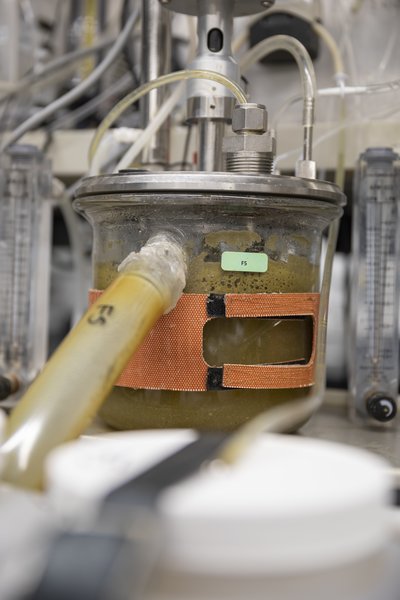
Rumen right along
Alumna Haley Larson gives us a gut check, shares science she’s applying at Cargill
If you like riddles, here’s one to ruminate on – What dual-flow device uses a dozen fermenters, runs on 48 liters of saliva daily and is completely computer automated?
Need a hint? Look no further than the scientific studies and work of Haley Larson, a senior research scientist in Cargill’s animal nutrition and health business and CFANS animal science graduate, BS '14, PhD ‘18.
Larson and her colleagues at Cargill led the development of an artificial rumen – in other words, a system that simulates what actually happens in the first compartment of a cow’s four stomachs.
Gut reactions
Larson explains that because the artificial rumen mimics a cow’s natural rumen cycle, it allows them to test different components of nutrition in an automated way. This is more efficient than using a cannula, which is a porthole-like device that allows access to a cow’s rumen to conduct research and analysis of its digestive system.
“We use this system to develop better products and feed formulations for farmers,” said Larson. “It’s a way for us to study the cow’s stomach, digestion and fermentation itself without applying treatments to live animals, which is expensive and requires a lot of time to analyze results.”
With the artificial rumen, Larson and her team are improving the efficiency of ruminant research. “The system increases the speed of research trials by boosting our ability to screen products and our capabilities for examining microbial activity in the rumen,” she said.
Rumen acumen
So just how did Larson get such “stomach science” smarts? The University of Minnesota played an instrumental role. Larson completed her doctoral degree with animal science professor Marshall Stern, PhD, on ruminant nutrition, and was co-advised by animal science professor Alfredo DiCostanzo, PhD. Stern has an artificial rumen setup as well, which gave Larson direct experience with a model system.
While completing her PhD, she worked part-time for Cargill to set up this artificial rumen simulation system. When the company hired her full-time in 2017, she began designing fermenter experiments to support Cargill’s global ruminant research portfolio supporting dairy and beef customers.
“At CFANS, I got a one-of-a-kind experience that really catapulted me to where I am today,” she said. She gives credit to having co-mentors that balanced exposure to work in the lab with a producer facing extension component. “I knew I could handle the science, but it was critical to me that my science could be translated and provide real value to farmers.”
Larson also credits her experience at the University of Minnesota – which was enabled in part by scholarships* supported by generous CFANS donors – for her expertise in bridging the gap between science and lab work. “My work at the U helped connect those worlds through my involvement in extension and being able to student teach as a graduate student,” she said. Today, she translates that teaching experience to her role at Cargill, which includes training interns, nutritionists, and customers.
Real results
While Larson and her team’s work is done with a rumen replica, the results are anything but artificial.
For example, automatic pH readings can pull gas samples in CO2 and methane, so they can see how different feeds shift microbial fermentation in cows and their contribution to greenhouse gases – contributing to Cargill’s overall sustainability initiatives.
In addition, the system supports new product development aimed at helping farmers with challenges they face in the field. “We can test new, innovative ideas before grade approval is sought to see how unique compounds might affect cows,” explained Larson.
There are only five dual flow artificial rumen setups actively producing research today, and the one Larson works with at Cargill is the only system that is completely computer automated with both gas analysis and pH control.
“Dual-flow continuous culture is the model that can simulate two separate flow rates of digesta leaving the vessel,” said Larson. This allows for the removal of liquid contents at a faster rate than solids, better mimicking natural flows of digesta in the gastrointestinal tract.
For Larson, the real satisfaction comes from knowing the innovative work she’s doing helps producers. “If I can impact a producer and make their day easier, if I can make things a little bit better or give them an extra hour with their families at the end of the day, or alleviate a headache or challenge they’re facing on the farm, that’s what it’s all about for me,” she said.
We’re sure this work is just one of the many important riddles and puzzles Larson will solve as she applies her CFANS experience of science driving a sustainable future to her work at Cargill, for Minnesota and for the world.
*Augustus L. Searle Scholarship, Robert Henton Scholarship, among others







